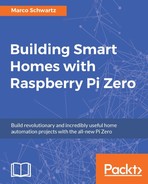In the first chapter of this book, we are going to go through all the steps that are required to configure your Raspberry Pi Zero board so you can use it for all the projects we will see in this book.
First we will look at the list of components that are required to use the board. Then, we will install the Raspbian distribution, which will be the operating system we will use throughout this book, on the board. Finally, we'll see how to configure the board for remote, and how to install the Node.js framework that we will use in nearly all the projects of the book. Let's start!
The Raspberry Pi Zero is a board that was introduced in 2015, and the goal was to make a low-cost ($5), small-format board with most of the functionalities of the original Raspberry Pi board.
The following is an image of the Zero board:

In the center of the board, you will find the same System-on-a-Chip (SoC) as the original Raspberry Pi board, with a 1-GHz single-core processor, 512 MB of RAM, and a graphical processing unit.
The board has several inputs and outputs, like the 40-pin GPIO connector that we will use through this whole book to connect the board to sensors and other components.
There are also two USB ports (one for power, one for communication), one mini-HDMI port, and one SD card slot to put the operating system and other files in.
The power consumption of the board was also reduced compared to the first board, going from 1.5W to 0.8W.
